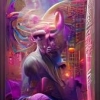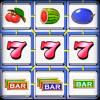Thujone may also be found in members of the genus
Artemisia, such as Absinthe Wormwood (
Artemisia absinthium). More on that after I provide some context.
About a year ago, I found myself in the depths of a deep depression (three words with the same root seems a bit redundant, but I digress) resulting from an unexpected move, which led to social withdrawal and self-imposed isolation. During this trough of my existence, I made some rather unwise decisions regarding recreational drug use; precipitated by immediate cessation of cannabis use after a year or so of chronic intake, due to lack of a "hook-up." In my desperate and foolish search for some substance to fill the void, I scoured Erowid and other internet resources for novel intoxicants that were relatively easy to acquire.
One such intoxicant with which I experimented was thujone from dried wormwood. The subjective "high" reported by fellow Erowid experimenters, which I experienced to some degree, was a "dollhouse effect" on the perception of reality. This was not a visual distortion, per se, but a tinge of unreality cast upon everything one sees; as if everything looked the same, yet seemed fake and contrived. These effects likely indicate derealization. From Wikipedia: "derealization is an alteration in the perception or experience of the external world so that it seems unreal. Other symptoms include feeling as though one's environment is lacking in spontaneity, emotional coloring and depth." [
http://en.wikipedia....i/Derealization] I am not sure if derealization is a known symptom of GABA
A antagonism, but there seems to be a lot of anecdotal evidence suggesting the link. Some of the other symptoms I experienced were cardiac dysrhythmia, intense anxiety, and mild convulsions. I cannot report any cognitive enhancement or increased focus, but I was not looking for those effects and my trial was with a dose likely too large to produce those results. The following article is the only one I was able to find which tested the link between attention performance and thujone. The results seems contrary to your hypothesis, however, thujone was administered concurrently with alcohol; alleviation of ADD symptoms was not the study's purpose; and thujone has actions other than GABA
A antagonism, which may complicate its use in treating ADD.
Absinthe:' class='bbc_url' title='External link' rel='nofollow external'>http://www.thujone.info/thujone-absinthe-5.html']Absinthe: Attention Performance and Mood under the Influence of Thujone
by A. Dettling, H. Grass, A. Schuff, G. Skopp, P. Strohbeck-Kuehner and H-Th. Haffner
Published in Journal of Studies on Alcohol, September 2004
OBJECTIVE:
The aim of this study was to determine whether the impacts of absinthe on attention performance and mood were different from those
experienced with beverages that contain only alcohol. The ingredient causing absinthe's toxicity is believed to be thujone.
METHOD:
A total of 25 healthy subjects participated in the study. An attention performance test and two questionnaires testing different mood
dimensions were used. Three drinks with an identical amount of alcohol but with different amounts of thujone were offered.
RESULTS:
The results of the present study showed that the simultaneous administration of alcohol containing a high concentration of thujone had
a negative effect on attention performance. Under this condition, the subjects tended to direct their attention to signals in the central field
of attention and to neglect peripheral signals; the number of correct reactions decreased significantly in the peripheral field of attention,
and reaction time and the number of "false alarm" reactions increased significantly. The effects were most prominent at the time of the
first measurement. When the subjects were under the influence of alcohol or were administered both alcohol and a low thujone
concentration, these effects were not observed. The assessment of mood state dimensions showed that the anxiolytic effect of alcohol
was temporarily counteracted by a high thujone concentration.
CONCLUSIONS:
As they are apparently opposed to the effect of alcohol, the reactions observed here can be explained by the antagonistic effect of
thujone on the gamma-aminobutyric acid receptor. Similar alterations were observed for the other mood state dimensions examined.
→ source (external link)













































